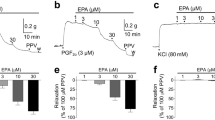Summary
A number of thromboxane (Tx) synthetase inhibitors have been found to prevent thromboxane release in acute cardiopulmonary disorders. However, little is known about Tx receptor antagonism by these substances. Imidazole, UK-37,248 and pinane thromboxane A2 (PTA2) were tested in isolated perfused cat coronary arteries, spirally cut rabbit pulmonary artery strips, and in rabbit and cat platelets for their ability to antagonize vasoconstrictor and aggregatory effects of a stable Tx agonist, carbocyclic thromboxane A2 (CTA2). Imidazole, at concentrations that completely inhibit thromboxane synthesis, failed to antagonize the vasoconstrictor effects of CTA2 in both systems. UK-37,248, at 10 to 1000 μg/ml, failed to inhibit CTA2-induced coronary constriction but at 1 μg/ml reduced rabbit pulmonary artery constriction by 80±8% (P<0.0005). In comparison, 1 μM PTA2 completely prevented PTA2-induced constriction in both coronary and pulmonary arteries. PTA2 did not antagonize KCl and angiotensin II responses. In platelets, PTA2 but not UK-37,248 prevented arachidonate induced aggregation in rabbit and cat platelets. Some of the beneficial effects of thromboxane synthetase inhibitors may be associated with thromboxane receptor antagonism. Inhibitors structurally similar to TxA2 appear to have greater thromboxane receptor antagonistic activity. This additional activity may be of importance in therapeutics of coronary and pulmonary disorders.
Similar content being viewed by others
References
Araki H, Lefer AM, Smith JB, Nicolaou KC, Magolda RL (1980) Beneficial actions of a new thromboxane analog in traumatic shock. In: Samuelsson B, Ramwell PW, Paoletti R (eds) Advances in prostaglandin and thromboxane research, vol 7, pp 835–838
Araki H, Peck RC, Lefer AM, Smith JB (1981) Mechanism of protection against arachidonate induced sudden death by glucocorticoid. Prostaglandins 21:387–399
Born GVR (1962) Aggregation of blood platelets by adenosine dephosphate and its reversal. Nature 194:926–927
Fitzpatrick FA, Bundy GL, Gorman RR, Honohan T (1978) 9,11-Epoxyiminoprosta-5,13-dienoic acid is a thromboxane A2 antagonist in human platelets. Nature 275:764–766
Furchgott RF (1960) Spiral-cut strip of rabbit aorta for in vitro studies of responses of arterial smooth muscle. In: Bruner HD (ed) Methods in medical research, vol 18. Yearbook Medical Publishers, Chicago, IL, p 13
Hamberg M, Svensson J, Samuelsson B (1975) Thromboxanes: A new group of biologically active compounds derived from prostaglandin endoperoxides. Proc Natl Acad Sci (USA) 72:2994–2998
Ingermanwojenski C, Silver MJ, Smith JB, Macarak E (1981) Bovine endothelial cells in culture produce thromboxane as well as prostacyclin. J Clin Invest 67:1292–1296
LeBreton GC, Venton DL, Enke SE, Halushka PV (1979) 13-Azoprostanoic acid: A specific antagonist of the human blood platelet thromboxane/endoperoxide receptor. Proc Natl Acad Sci (USA) 76:4097–4101
Lefer AM, Ogletree ML, Smith EF, III (1981b) Role of prostanoids in acute myocardial ischemia. In: Forster W (ed) Prostaglandins and thromboxanes in the cardiovascular system and in gynaecology and obstetrics. Proceedings of the 3rd International Symposium on Prostaglandins and Thromboxanes in the Cardiovascular System, Halle/Saale, GDR, May 5–7, 1980. VEB Gustav Fischer, Jena, pp 15–20
Lefer AM, Okamatsu S, Smith EF III, SMith JB (1981) Benefical effects of a new thromboxane synthetase inhibitor in arachidonate-induced sudden death. Thrombosis Res 23:265–273
Lefer AM, Smith EF, III, Araki H, Smith JB, Aharony D, Claremon DA, Magolda RL, Nicolaou KC (1980) Dissociation of vasoconstrictor and platelet aggregatory activities of thromboxane by carbocyclic thromboxane A2, a stable analog of thromboxane A2. Proc Natl Acad Sci (USA) 77:1706–1710
Lefer AM, Smith JB, Nicolaou KC (1981a) Cardiovascular actions of two thromboxane A2 analogs. In: Kovach AGB, Hamar J, Szabo L (eds) Cardiovascular physiology: Microcirculation and capillary exchange. Adv Physiol Sci, vol 7. Pergamon Press, London, pp 91–98
Lewy RI, Wiener L, Walinsky P, Lefer AM, Silver MJ, Smith JB (1980) Thromboxane release during pacing induced angina pectoris: possible vasoconstrictor influence on the coronary vasculature. Circulation 61:1165–1171
Nicolaou KC, Magolda RL, Smith JB, Aharony D, Smith EF III, Lefer AM (1979) Synthesis and biological properties of pinanethromboxane A2 (PTA2). A selective inhibitor of coronary artery constriction, platelet aggregation and thromboxane formation. Proc Natl Acad Sci (USA) 70:2566–2590
Ogletree ML, Smith JB, Lefer AM (1978) Actions of prostaglandins on isolated perfused cat coronary arteries. Am J Physiol 235:H400-H406
Schror K, Smith EF, III, Bickerton M, Smith JB, Nicolaou KC, Magolda R, Lefer AM (1980) Preservation of the ischemic myocardium in pinane thromboxane. Am J Physiol 238:H87-H92
Smith EF, III, Lefer AM, Smith JB (1980) Influence of thromboxane inhibition on the severity of myocardial ischemia in cats. Can J Physiol Pharmacol 58:194–300
Smith EF, III, Tabas JH, Lefer AM (1980) Beneficial actions of imidazole in endotoxin shock. Prostglandins Med 4:215–225
Smith EF, III, Lefer AM, Aharony D, Smith JB, Magolda RL, Claremon D, Nicolaou KC (1981) Carbocyclic thromboxane A2: Aggregation of myocardial ischemia by a new synthetic thromboxane A2 analog. Prostaglandins 21:443–456
Smith EF, III, Lefer AM, Nicolaou KC (1981) Mechanism of coronary vasoconstriction induced by carbocyclic thromboxane A2. Am J Physiol 240:H493-H497
Smith EF, III, Schmunk GA, Lefer AM (1981) Antagonism of thromboxane vasoconstriction by non-steroidal anti-inflammatory agents. Fed Proc (abstract) 40:689
Smith JB, Araki H, Lefer AM (1980) Thromboxane A2, prostacyclin and aspirin: effects on vascular tone and platelet aggregation. Circulation (Suppl V) 62:V19–25
Tyler HM, Saxton CAPD, Parry MJ (1981) Administration to man of UK-37,248-01, a selective inhibitor of thromboxane synthetase. Lancet 1:629–632
Vermylen J, Carreras LO, Schaeren JV, Defreyn G, Machin SJ, Verstraete M (1981) Thromboxane synthetase inhibition as antithrombotic strategy. Lancet 1:1073–1075
Author information
Authors and Affiliations
Additional information
Supported in part by a grant from the W. W. Smith Charitable Trust
Rights and permissions
About this article
Cite this article
Smith, E.F., Lefer, A.M., Smith, J.B. et al. Thromboxane synthetase inhibitors differentially antagonize thromboxane receptors in vascular smooth muscle. Naunyn-Schmiedeberg's Arch. Pharmacol. 318, 130–134 (1981). https://doi.org/10.1007/BF00508837
Received:
Accepted:
Issue Date:
DOI: https://doi.org/10.1007/BF00508837



